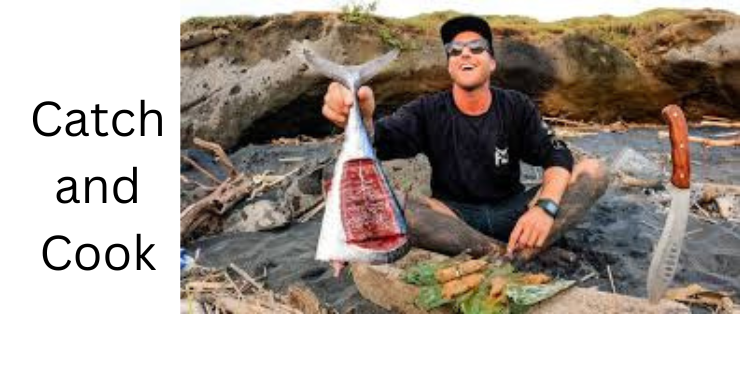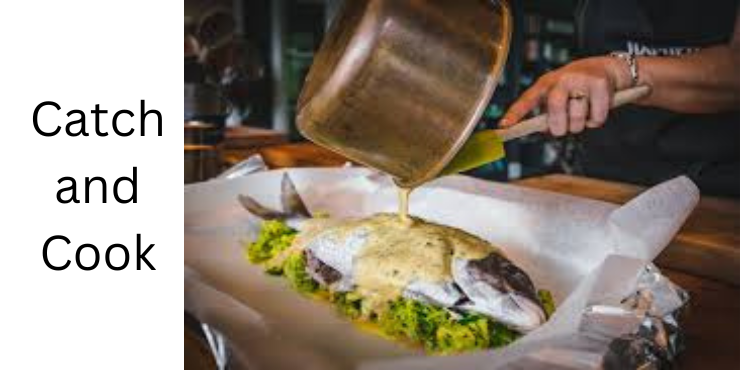Table of Contents
Introduction to Catch and Cook
Catch and cook is a culinary trend that’s gaining momentum, allowing enthusiasts to enjoy the freshest seafood right from their local waters. It involves catching your own fish, shellfish, or other aquatic creatures and then preparing them into delicious meals in the comfort of your own kitchen. This trend has caught on due to its emphasis on freshness, sustainability, and the unique connection it provides to nature.
Benefits of Catch and Cook
Freshness and Quality of Ingredients

One of the primary advantages of catch and cook is the unparalleled freshness of the ingredients. Unlike store-bought seafood, which may have been sitting on ice for days, the fish you catch yourself is as fresh as it gets. This freshness translates into superior taste and texture, elevating your culinary creations to new heights.
Sustainability
By catching your own seafood, you have full control over where it comes from and how it’s harvested. This allows you to prioritize sustainability by adhering to catch limits, avoiding sensitive habitats, and practicing responsible fishing techniques. By reducing reliance on commercially harvested seafood, you’re doing your part to preserve marine ecosystems for future generations.
Connection to Nature
There’s something incredibly rewarding about catching your own food directly from the source. It provides a sense of accomplishment and connection to nature that’s hard to replicate with store-bought ingredients. Whether you’re casting a line from a tranquil lake or foraging for shellfish along the shore, the experience of sourcing your own food can be both meditative and exhilarating.
Getting Started with Catch and Cook
Choosing the Right Location

The first step in catch and cook is selecting the perfect location for your fishing expedition. Whether you prefer freshwater or saltwater fishing, there are countless options to explore. Research local regulations and fishing hotspots in your area to find the best spots for your culinary adventure.
Equipment Needed
To embark on your catch and cook journey, you’ll need the right gear. This typically includes fishing rods, reels, bait, and tackle for angling, as well as nets, traps, or dive gear for harvesting shellfish. Invest in high-quality equipment suited to your chosen fishing method to maximize your chances of success.
Safety Precautions
Checking Local Regulations
Before heading out on your fishing expedition, familiarize yourself with local regulations and licensing requirements. Different regions may have specific rules regarding catch limits, seasons, and permitted fishing methods. Failure to comply with these regulations can result in fines or other penalties, so it’s essential to do your homework beforehand.
Proper Handling and Storage of Seafood
Once you’ve caught your seafood, it’s crucial to handle and store it properly to maintain freshness and prevent foodborne illness. Clean and gut the fish as soon as possible, removing any entrails and rinsing the body cavity with cold water. Store seafood on ice or in a cooler until you’re ready to cook it to ensure it stays fresh and safe to eat.
Techniques for Catch and Cook
Fishing Tips
To increase your chances of success while fishing, consider factors such as time of day, weather conditions, and the behavior of the target species. Experiment with different bait and lure combinations to entice fish to bite, and be patient and persistent until you find a productive spot.
Cleaning and Preparing the Catch
After catching your seafood, it’s essential to clean and prepare it properly before cooking. Use a sharp knife to fillet or dress the fish, removing scales, fins, and any remaining entrails. For shellfish, such as clams or mussels, scrub them thoroughly under cold water to remove dirt and debris.
Popular Catch and Cook Recipes
Grilled Fish with Herbs
One of the simplest and most delicious ways to prepare freshly caught fish is by grilling it with a medley of aromatic herbs. Marinate the fish in a mixture of olive oil, lemon juice, garlic, and fresh herbs such as rosemary, thyme, and parsley. Grill the fish over medium-high heat until it’s cooked through and flakes easily with a fork, then serve with additional herbs and lemon wedges for garnish.
Pan-Seared Scallops
For a luxurious seafood dish that’s sure to impress, try pan-searing fresh scallops to perfection. Pat the scallops dry with paper towels to ensure a crispy exterior, then season them with salt and pepper. Heat a skillet over high heat and add a small amount of butter or oil. Sear the scallops for 1-2 minutes on each side until they’re golden brown and caramelized, then serve immediately with a squeeze of lemon juice.
Fish Tacos with Homemade Salsa
For a flavorful and satisfying meal that’s perfect for sharing, whip up a batch of fish tacos with homemade salsa. Start by seasoning your fish fillets with a blend of chili powder, cumin, garlic powder, and lime juice. Grill or pan-sear the fish until it’s cooked through, then flake it into bite-sized pieces. Serve the fish in warm tortillas with fresh salsa made from diced tomatoes, onions, cilantro, and jalapenos, and top with a dollop of creamy avocado sauce.
Tips for Success
Patience and Perseverance
Successful catch and cook requires patience and perseverance, as fishing can be unpredictable at times. Don’t get discouraged if you don’t catch anything right away – keep experimenting with different techniques and locations until you find what works for you.
Experimenting with Flavors
Part of the fun of catch and cook is experimenting with different flavors and culinary techniques. Don’t be afraid to get creative with your recipes, incorporating bold spices, fresh herbs, and innovative cooking methods to elevate your dishes to new heights.
Environmental Impact
Importance of Responsible Fishing Practices
As stewards of the ocean, it’s essential for catch and cook enthusiasts to prioritize responsible fishing practices. This means respecting catch limits, avoiding sensitive habitats, and releasing undersized or non-target species unharmed. By taking care to minimize our impact on marine ecosystems, we can ensure that future generations will be able to enjoy the thrill of catching and cooking for years to come.
Avoiding Overfishing
Overfishing is a significant threat to marine biodiversity, depleting fish stocks and disrupting fragile ecosystems. To mitigate this risk, catch and cook enthusiasts must fish responsibly and adhere to sustainable harvesting practices. By only taking what we need and respecting the natural balance of marine ecosystems, we can help preserve the health and abundance of our oceans for generations to come.
Community and Sharing
Sharing Recipes and Experiences
One of the joys of catch and cook is sharing recipes and experiences with other enthusiasts. Whether it’s swapping tips on the best fishing spots or exchanging culinary creations, the catch-and-cook community is a vibrant and welcoming one. Join online forums, attend local fishing events, and connect with like-minded individuals who share your passion for fresh, sustainable seafood.
Building Connections with Other Enthusiasts
Catch and cook is more than just a culinary trend – it’s a lifestyle that fosters camaraderie and connection among fellow seafood lovers. Whether you’re bonding over a shared fishing trip or collaborating on a delicious seafood feast, the friendships forged through catch and cook are as rewarding as the meals themselves.
Conclusion
In conclusion, catch and cook offers a unique opportunity to enjoy the freshest seafood while connecting with nature and fostering a sense of stewardship for our marine environment. By embracing this culinary trend and following responsible fishing practices, you can savor delicious meals while supporting sustainable seafood harvests for future generations to enjoy.
FAQs
- Is catch and cook suitable for beginners? Absolutely! Catch and cook is accessible to people of all skill levels, whether you’re an experienced angler or a complete novice. With a bit of patience and practice, anyone can enjoy the thrill of catching and cooking their own seafood.
- Do I need a lot of expensive equipment to start catch and cook? Not necessarily. While high-quality fishing gear can enhance your experience, you don’t need to break the bank to get started with catch and cook. Start with basic equipment and gradually invest in additional gear as you gain experience and confidence.
- How can I ensure that I’m fishing responsibly? Responsible fishing involves respecting catch limits, avoiding sensitive habitats, and releasing undersized or non-target species unharmed. Familiarize yourself with local regulations and best practices to ensure that you’re fishing in an environmentally sustainable manner.
- What are some beginner-friendly fish to target for catching and cooking? Common beginner-friendly species for catching and cooking include trout, catfish, bass, and panfish. These fish are relatively easy to catch and prepare, making them ideal choices for novice anglers.
- Are there any safety precautions I should take when handling seafood? Yes, it’s essential to handle seafood safely to prevent foodborne illness. Always clean and gut fish promptly after catching them, and store seafood on ice or in a cooler until you’re ready to cook it. Additionally, cook seafood to the recommended internal temperature to ensure that it’s safe to eat.

